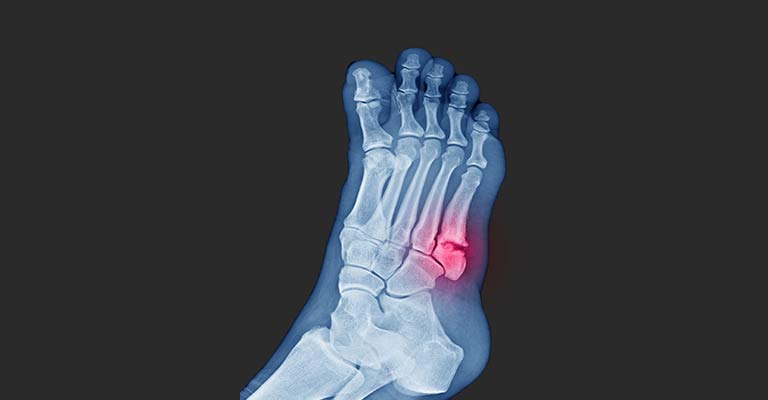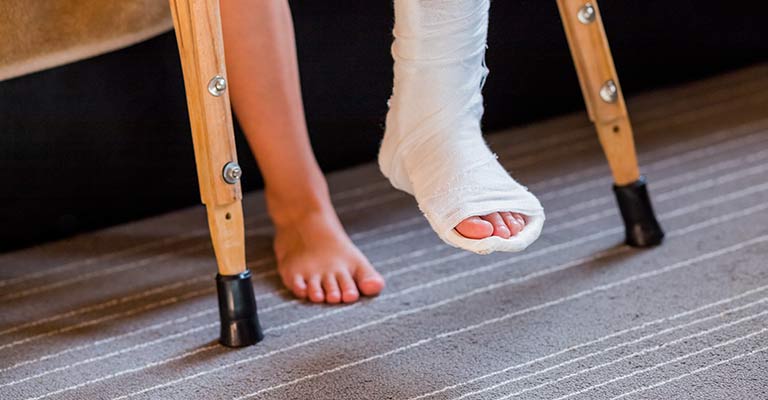Jones Fracture : Causes, Symptoms, Treatments & Recovery
Do you know that according to data, fractures account for an estimated 16% of all musculoskeletal injuries in the US yearly? It’s believed that about 40% of all fractures occur at home and that 6.3 million fractures occur annually in America.
It’s likely that you have not heard about a Jones fracture. This injury can be painful and often requires medical treatment. If you’re interested in learning about everything a Jones fracture, our guide will help.
We will discuss everything from the symptoms and causes of the various treatments. We will also look at how long the recovery period is.
What Is A Jones Fracture?

A Jones fracture is named after Sir Robert Jones, an orthopedic surgeon. In 1902 Jones recorded his own injury and found several other people with the same injury. Thus this makes him the first person to discover it.
Often many people get confused whether they have a Jones fracture or an Avulsion Fracture. This is because the two injuries occur on the same bone. However, these fractures are different injuries.
So what exactly is a Jones fracture? To put it simply, a Jones fracture is a type of broken bone injury. This injury will occur when you break your fifth metatarsal bone. This bone joins the base of your foot to your foot’s pinkie toe. Contrary to popular belief, the Jones fracture is the most common metatarsal fracture.
What Are The Symptoms Associated With Fracture?
When you fracture a bone, it means that you break it. Thus, if you’re experiencing a Jones fracture, you are experiencing a break. Often a Jones fracture is painful, and if not treated, it can develop into another injury.
Luckily, there are a few common symptoms those with a Jones fracture suffer from. If you have pain by the middle outside of your foot or any of the below symptoms, you might have a Jones fracture.
- Minor to severe pain.
- Minor to severe swelling.
- Tenderness along your fifth metatarsal.
- Discoloration or bruising on your foot.
- Difficulty walking.
- A bump on your foot that is not usually present.
Causes Associated With Jones Fracture

A Jones fracture is caused by a specific stressful or traumatic event. Or it is from chronic overuse in most cases. Let’s break these concepts down.
When a Jones fracture occurs because of a traumatic event, it’s usually because of a type of inversion sprain. This type of sprain happens when your foot is turned inwards toward your other foot.
Traumatic Jones fractures occur when playing sports like basketball or football. It can also happen if you twist or quickly change the direction of your foot.
If your fracture happens because of a chronic injury, it’s because of repetitive overuse injuries. Repetitive overuse injuries can cause cracks on your bone or weaken it. This then allows an acute break or Jones fracture to occur.
Who Gets Jones Fractures Easily?

Now that you know what a Jones fracture is, you’re likely wondering who gets this type of injury. Despite what you might believe, a Jones fracture can happen to anyone. Yet, you’re more at risk of this type of foot fracture if you are someone who places a lot of stress on your feet regularly.
Examples of people who place a lot of stress on their feet include dancers, workers who have to stand a lot, and athletes. Additionally, others routinely suffer this injury. These others include women who are usually older than 70 and men older than 30.
You’re also more likely to develop a Jones fracture if you have osteoporosis. Moreover, you are also more likely to suffer a Jones fracture if you have high arched feet. This is because those with high arched feet place more pressure on the outside of their feet.
Is Jones Fracture Just An Ankle Sprain?
It can be easy to believe that a Jones fracture is an ankle sprain, but it is not. Often a Jones fracture can occur because of an inversion type sprain of the ankle.
Yet, this is not in and of itself an ankle sprain. The inversion type ankle sprain that causes a Jones fracture can cause an ankle fracture. That’s likely where the confusion arises.
When To See A Doctor If You suspect Have Jones Fracture?

If you suspect that you have a Jones fracture, you should immediately seek medical attention from a doctor. A doctor can tell you the best treatment plan for your situation. To help you determine when you should see a doctor, we have listed the below signs to look out for.
- When you develop a fever.
- When the pain, swelling, bruising, or tenderness on the affected foot worsens.
- When your foot goes purple or blue, and this discoloration begins to spread.
- If your foot becomes numb or tingles.
The Treatments Available For A Jones Fracture
Are you curious about how a Jones fracture is treated? If so, you might want to look at the surgical and non-surgical treatment options available to you.
Non-Surgical Treatment

When you sustain a Jones fracture, your doctor can choose to offer you non-surgical treatment if your injury isn’t too severe. With non-surgical treatment, you will need to take pressure off your foot. Often this will allow it to heal on its own without intervention.
Often when opting to go the non-surgical route, you will need to wear a special boot on your foot. This boot will prevent too much movement while allowing you to retain movements. In addition to the boot, you will have to use crutches while your Jones fracture heals.
One of the biggest advantages of choosing a non-surgical route to heal your fracture is that you won’t need to endure the discomfort of surgery. You will need to wear the cast and use crutches for six to eight weeks in many instances.
Surgical Treatment

If your Jones fracture is bad enough to require surgery, a surgeon will need to place a screw into your metatarsal bone. This screw helps your bone bend and twist after it has healed. Often, this screw will be left inside your bone after it heals and will only be taken out if you experience pain.
Yet, you should note that your doctor could choose to use a bone plate depending on your case. A bone plate will be used if the screw in your foot needs to be secured. There is also a procedure where the damaged bone in your foot will be removed around the area of your fracture. Once the bone is taken out, a doctor will place a bone graft before putting in a screw.
After your surgery, your doctor could also make you go to physiotherapy to ensure your foot heals as it should. Seeing a physiotherapist will ensure you retain or obtain complete maneuverability.
Jones Fracture Recovery Time
Regardless of if you need surgery or not to heal your Jones fracture, your recovery period will be the same unless you reinjure it. Often this type of fracture takes between 6 to 8 weeks to heal.
Yet, if you are healing your fracture without surgery, it could take up to three months for it to heal completely.
Walking After A Jones Fracture With Crutches

If you have a Jones fracture, your biggest concern likely is how you will be able to walk while it heals. Whether you seek non-surgical or surgical treatment, you will need to use a mobility aid. A mobility aid will allow you to keep doing the tasks you need to get done in a day.
Using crutches while you are healing without surgery can speed up the healing process. It can also help you prevent reinjuring your foot. Unfortunately, any type of fracture, including a Jones fracture, can be painful, and this pain is amplified if you had surgery. That means by any means necessary; you need to keep your fracture safe so that it can heal.
This is likely why a doctor will tell you that you have to be non-weight bearing. Since you won’t be able to place any weight on your foot for several weeks, you will need to use crutches. Like non-surgical treatment, crutches will help you heal faster from your surgery.
Usually, a doctor will tell you how best to use your crutches so that you don’t end up reinjuring your Jones fracture. Yet, most often, you would be offered either a knee crutch which is a hands-free crutch, or traditional crutches that fit under your armpits.
A knee crutch can be handy because it frees up your hands; however, you could become tired quickly. With traditional armpit crutches, you can evenly distribute your weight while completing tasks.
The Wrap-Up!
Now you are aware of everything you need to know about a Jones fracture. It is undeniable that this injury can be incredibly painful and can affect life. Yet, you can determine if you have a Jones fracture and the treatment you should undertake with the information we gave.
As long as you remember to watch out for the symptoms and talk with a doctor when you see alarming signs, you should have no issues making a full recovery. Additionally, you should not forget that crutches play an integral part in your recovery. Without them, you could wait months for your Jones fracture to heal, and you could risk reinjuring it.
Keep your crutches on hand, rest and relax, and attend your follow-up appointments. If you do this, you will be happier and healthier in no time!

